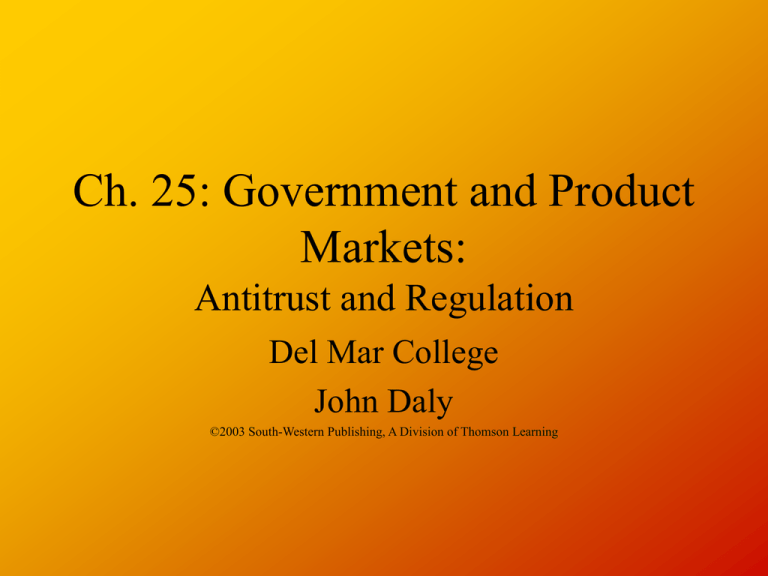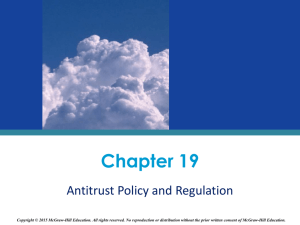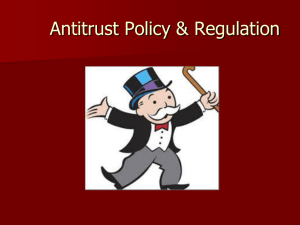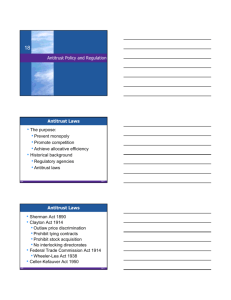Document
advertisement

Ch. 25: Government and Product Markets: Antitrust and Regulation Del Mar College John Daly ©2003 South-Western Publishing, A Division of Thomson Learning Antitrust • Antitrust Law is legislation passed for the stated purpose of controlling monopoly power and preserving and promoting competition. • Trust: A combination of firms that come together to act as a monopolist The Sherman Act (1890) • Every contract, combination in the form of trust or otherwise, or conspiracy, in restraint of trade or commerce among the several states, or with foreign nations, is hereby declared to be illegal. • Every person who shall monopolize, or attempt to monopolize, or combine or conspire with any other person or persons to monopolize any part of the trade or commerce…shall be guilty of a misdemeanor. The Clayton Act (1914) The Following were made illegal by this act: • Price Discrimination • Exclusive Dealing • Tying Contracts • Acquisition of competing companies stock if the acquisition reduces competition. • Interlocking directorates – an arrangement whereby the directors of one company sit on the board of directors of another company in the same industry Other Antitrust Acts • Federal Trade Commission Act: unfair methods of competition in commerce declared illegal (1914) • Robinson-Patman Act: prohibits suppliers from offering special discounts to large chain stores unless they also offer the discounts to everyone else.(1936) • Wheeler-Lea Act: empowers the Federal Trade Commission to deal with false and deceptive acts or practices.(1938) • Celler-Kefauver Antimerger Act: designed to close the merger loophole that remained in the Clayton Act. It bans anticompetitive mergers that occur as a result of one company acquiring the physical assets of another company. (1950) Unsettled Points in Antitrust Policy • Does the Definition of the Market Matter? • Concentration Ratios: measured with the Herfindahl Index – measures the degree of concentration in an industry. It is equal to the sum of the squares of the market shares of each firm in the industry • Concentration Ratios: Don’t take into account foreign competition; ratio can remain stable over time even though there is competition within the industry. A Comparison of the Four Firm concentration ratio and the Herfindahl Index Using the old method (in this case, the four-firm concentration ratio), the top four firms in the industry have a 48% market share. The Justice Department would likely frown on a proposed merger between any of the top four firms and any other firm. However, the Herfindahl Index of 932 is representative of unconcentrated industry. Antitrust and Mergers The reason government looks most carefully at proposed horizontal mergers is they are more likely to change the degree of concentration or competition in an industry Mergers • Horizontal Merger is a merger between firms that are selling similar products in the same market • Vertical Merger is a merger between companies in the same industry, but at different stages of the production process. • Conglomerate Merger is a merger between companies in different industries. Nine Antitrust Cases And Actions • • • • • • • Von’s Grocery Utah Pie Continental Airlines IBM Universities Microsoft and Intuit Lockheed Martin and Northrup Grumman • Boeing and McDonnell Douglas • Genetech and Roche Antitrust and Network Monopolies • A network good is a good whose value increases as the expected number of units sold increases. • Currently, the antitrust authorities do not move against a network monopoly because of what it is, but because of how it behaves. United States of America V. Microsoft: Civil Action No. 98-1232 • MS Windows is used on more than 80 percent of Intel-based PCs. • There are high barriers to entry in the market for PC operating systems essentially because MS Windows is a network good that is the industry standard. • Justice Department claimed Microsoft was using the dominance in the Operating System market not only to maintain a monopoly, but to gain dominance in the Internet browser market. Q&A • Why does it matter whether a market is defined broadly or narrowly for purposes of antitrust policy? • There are 20 firms in an industry and each firm has a 5% market share. What is the four-firm concentration ration and the Herfindahl index for this industry? • What is the advantage of the Herfindahl index over the four-firm and eight-firm concentration ratios? Explain your answer. The Case of the Natural Monopoly • If economies of scale are so pronounced or large in an industry that only one firm can survive, that firm is a natural monopoly. • Examples of this are local electricity suppliers, gas, and water service. • Natural monopoly exists where one firm can supply the entire output demanded at lower cost than two or more firms can. It is a natural monopoly because a monopoly situation will naturally evolve over time as the low-cost producer undercuts its competitors. The Natural Monopoly Situation The only existing firm produces Q1 at an average total cost of ATC1. Resource allocative efficiency exists at Q2. There are two ways to obtain this output level: the only existing firm can increase its production to Q2 or a new firm can enter the market and produce Q3 which is the difference between Q2 and Q1. The first way minimizes total cost, the second way does not. This is a natural monopoly situation: One firm can supply the entire output demanded at a lower cost than two or more firms can. The Profit-Maximizing Natural Monopoly The natural monopoly that seeks to maximize profits will produce the quantity of output at which MR = MC and charge the monopoly price P1. Regulating the Natural Monopoly • Price Regulation • Profit Regulation • Output Regulation Regulation of a natural monopoly does not always turn out the way it was intended. Each type of regulation requires information, and each type of regulation can suffer from regulatory lag – the time period between when a natural monopoly’s costs change and when the regulatory agency adjusts prices of the natural monopoly. Regulating a Natural Monopoly The government can regulate a natural monopoly through (1) price regulation, (2) profit regulation, or (3)output regulation. Price regulation usually means marginal cost pricing and profit regulation usually means average cost pricing. Theories of Regulation Capture Theory: no matter the motive for the initial regulation and the establishment of the regulatory agency, eventually the agency will be controlled by the special interests of the industry that is being regulated. Reasons sited include: • Persons who have been in the industry are asked to regulate the industry because they know the most about it. • At regulatory hearings, members of the industry attend in greater force than taxpayers or consumers. • Members of the regulated industry make a point of getting to know the members of the regulatory agency. • After they retire or quit their jobs, regulators often go to work for the industry they once regulated. Theories of Regulation (II) • Public Interest Theory: regulators are seeking to do, and will do through regulation, what is in the best interest of the public or society at large. • Public Choice Theory: regulators are seeking to do, and will do through regulation, what is in their best interest (specifically, to enhance their power and the size and budget of their regulatory agencies. Social Regulation • Is concerned with the conditions under which goods and services are produced and the safety of these items to the consumer. • Not everyone agrees on the worth of social regulation: some say it is too expensive and too invasive; others say government regulation of businesses is important because of atrocious things can happen without it. Costs and Benefits of Regulation • • • • Benefits can be made to improve society. Regulations come with costs as well as benefits. There are also unintended effects of regulation. A regulation requiring car companies to produce cars that get better fuel mileage may have a side effect: people purchase and burn more gasoline and thus produce more air pollution, not less as the government intended. Deregulation • Many economists, basing their arguments on the capture and public choice theories of regulation, argued that regulation was actually promoting and protecting market power instead of reducing it. • Deregulation has led to a decline in costs in various institutions. • Example: The Telecommunications Act of 1996 may give consumers one stop shopping for their cable TV, telephone (local and long distance), internet, and wireless needs. Q&A • What is a criticism of average cost pricing? • State the essence of the capture theory of regulation. • What is the difference between the capture theory and the public choice theory of regulation? • Are economists for or against social regulation?






